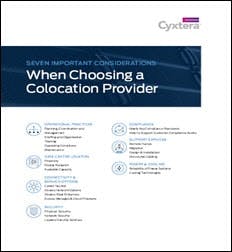This is the first post in a four-part series that explores the seven most crucial elements to consider before choosing a colocation provider. This post focuses on whether your colocation provider has the necessary practices and methods to ensure maximum uptime.
Download the full report.
Colocation services may seem like nothing more than a commodity; a data center is a data center. However, what may appear as just minor differences between providers can have a major impact on the overall performance of your business.
With applications supporting your key customer interactions and business functions, all aspects of your IT infrastructure, including your colocation provider, need to be scrutinized. Whether it is an improved customer experience, 100 percent uptime for your critical applications or better alignment of IT with your business priorities, careful consideration of your colocation services provider will impact your ability to achieve these goals.
From physical location to network integration, there are important elements to consider when placing your hardware with a colocation data center. Asking the right questions can ensure an optimal deployment. Any latencies or points of failure need to be be eliminated or minimized to secure the performance of your business applications. Redundant systems help protect your business and keep it operating to serve your customers, no matter what unforeseen events may arise. Also, having a secure environment protects your business from instrusions that can have a devastating impact on your business.
[clickToTweet tweet=”The Uptime Institute reports that 70 percent of all data center outages are results of human error. #colocation” quote=”The Uptime Institute reports that 70 percent of all data center outages are results of human error.”]
Each business’s needs are slightly different, and you should bear in mind the operational dynamics that make your business unique. That said, the seven considerations discussed in this series are relevant to all colocation environments that clients deploy. They are the essential building blocks of a colocation program, and it is critical to select a provider that can deliver on all these attributes.
Does My Colocation Provider Have the Necessary Practices and Methods to Assure Maximum Uptime?
The Uptime Institute reports that 70 percent of all data center outages are results of human error. No matter how resilient a data center’s design and construction, you can still have outages if the operations team does not manage and operate the facility with an eye toward operational excellence. One way of accessing the operational practices of a data center is to look for the Uptime Institue Management and Operations Stamp of Approval. the Uptime Institute M&O Stamp of Approval provides a means to conduct risk analysis by examining five key behaviors:
Together, these behaviors assess the operational practices of a data center with a focus on the areas most often cited as the root cause of the human errors that adversely impact data center operation. The M&O Stamp of Approval validates the rigor and effectiveness of the facility management and operation and gives stakeholders the assurance they need that effective risk mitigation is in place.
Over the next few weeks, this series will also cover the following topics:
- The Importance of Data Center Proximity
- How Does my Colocation Provider Ensure Physical and Virtual Security?
- Colocation Provider Support: How to Choose Your Partner
You can download the full report here, courtesy of Cyxtera, “Seven Important Considerations When Choosing a Colocation Provider.”






